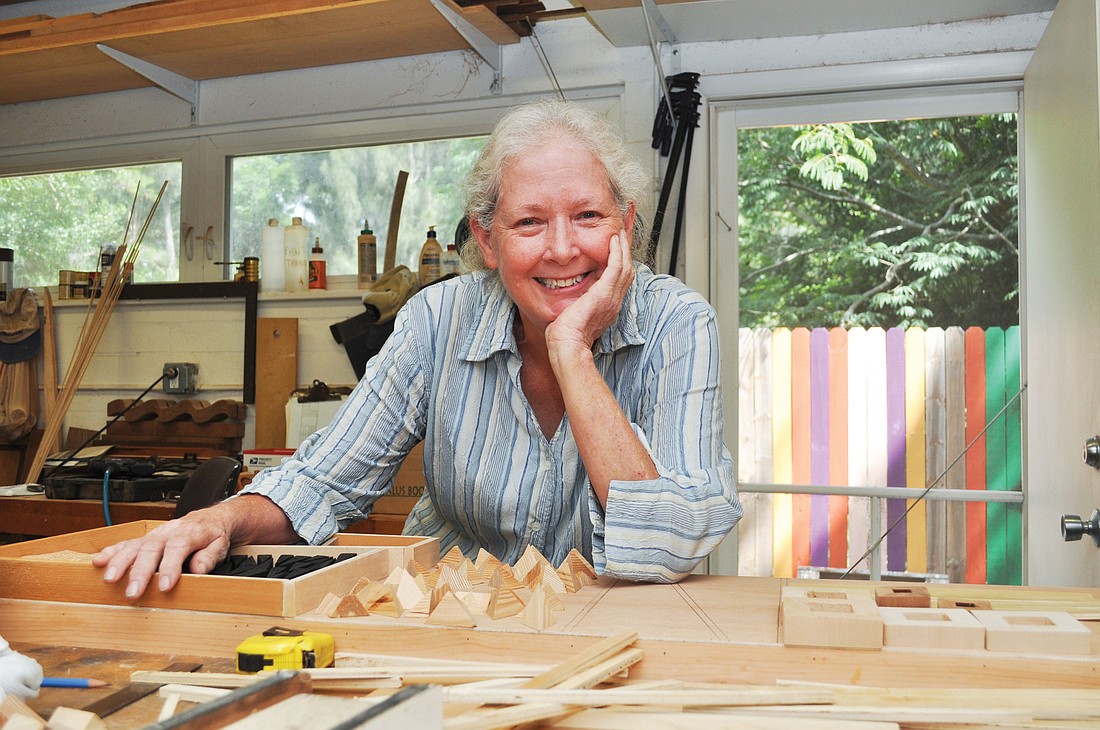- April 25, 2024
-
-
Loading

Loading

Pat Pettit’s hands are her most valuable piece of equipment.
In a woodshop outfitted with power tools, hardware and enough lumber to build a yacht, it’s Pettit’s hands that get the job done. Her fingers are long, tough and unadorned. Her nails are unpainted and clipped to a sensible length. When Pettit, a retired furniture-maker, speaks, she rests her palms in her lap as if to give them a break from years of sawing, sanding, hammering and staining.
Asked to describe her long career in the custom furniture business, the 62-year-old Sarasota resident routinely falls back on this one remark: “I worked with my hands.”
Like Pettit, the statement is understated. For four decades she used her hands to build some of the finest furniture in Sarasota. Many of her pieces — chests, cabinets, tables and beds — are now family heirlooms.
A New Jersey native, Pettit had no formal training when she got her hands on a stack of old cypress boards tossed outside of St. Martha Catholic Church in downtown Sarasota. Her mother was a seamstress. Her sister was a quilter and her father built model trains, so Pettit figured she also had a natural inclination to make things from scratch.
She built a long low credenza and sold the piece to a friend; the commission launched a long successful career as a furniture-maker –– first as one half of Pettit Fine Furniture with then-husband Bill Pettit, and later on her own, as a one-woman operation.
“I learned by doing,” she says. “I had no formal training.”
Now semi-retired, Pettit is learning by doing all over again, this time as a wood sculptor.
Four years ago, the artisan found herself staring at boxes of shop scraps; hundreds of castoff pieces squirreled away like dusty keepsakes. Sometimes she kept pieces for their texture, sometimes for their color and sometimes for their shape.
“The stuff that landed on the floor intrigued me,” Pettit says. “A lot of ’em were too nice to throw out.”
She created her first wood collage using scraps and found objects, including corrugated cardboard, woven wallpaper, cabinet knobs, nails, clothespins, washers, a slotted spoon, a metal chain and tools pulled from her father’s sail maker’s kit. She arranged the objects into a loose pattern, glued them to a large wooden canvas and then coated the assemblage with black house paint to achieve a textured, monochromatic effect.
Pettit’s longtime friends and clients were not surprised to see the pragmatic furniture-maker take a stab at making art for art’s sake.
“There are artists who have creativity, and then there are artists who have creativity and can still make substantial things that last,” says Kate Korp, a painter, printmaker and retired State College of Florida, Manatee-Sarasota art teacher. “One thing you can count on with Pat is that her artistic skills are as extraordinary as her craftsmanship.”
At first Pettit was hesitant to show off her collage. After spending so many years building functional, high-end furniture, she feared her new foray into abstract sculpture might be viewed as frivolous. Was she the only person who saw beauty in random woodcuttings and garage “doo-hickeys,” as she often refers to them?
Much to the artist’s delight, friends and family loved the work, and soon Pettit was working on a follow-up piece, a walnut relief sculpture sectioned off into squares.
Unlike the first work, Pettit meticulously mapped out her second wall sculpture. She cut each square and embellishment to fit the canvas and then applied a lacquer to the walnut to create a kind of wooden crazy quilt. She titled the work “Minimalist Quadrilateral Forms” and entered it in an art show at Art Center Sarasota, where it nabbed an honorable mention –– her first real kudos as an artist.
She quickly created a third piece depicting faces in a long rectangular box. When it sold for close to $500, Petit felt a tinge of validation as an artist.
“Her craft is just impeccable,” says Emma Thurgood, exhibitions coordinator at Art Center Sarasota. “The wood she chooses and the way she finishes it, it’s kind of like collaging with wood. Her pieces are always something to talk about, particularly her abstracts. They’re so intricate.”
Thurgood likens Pettit’s work to that of 20th century feminist sculptor Louise Nevelson, who was revered in the 1950s for her monochromatic wooden wall pieces crafted from recycled and found materials.
Like Nevelson, Pettit, who has two grown sons, is fiercely independent. Take, for example, the home she purchased seven years ago on Wilkinson Road. A one-story fixer-upper, Pettit immediately started ripping the house apart when she moved in. She laid the tile floor. She installed the trim carpentry. She built a new kitchen, refinished old doors and restored the terrazzo floors. When the work was done, and her vision complete, she hired a contractor to build a 300-sqaure-foot studio in her backyard.
“It’s not air-conditioned, so this time of year I work mostly in the morning,” she says. “I’ll take out my boxes of scraps, start digging through them and wait for something to suggest itself.”